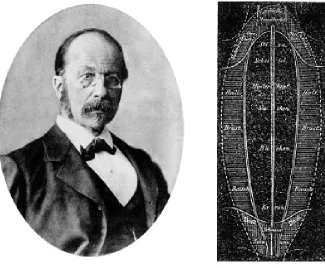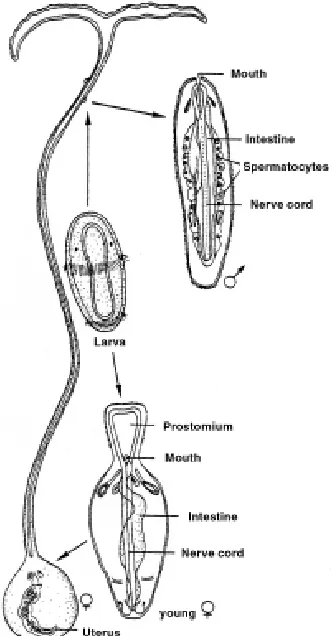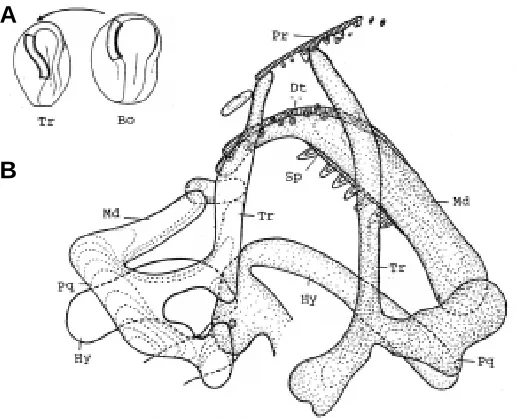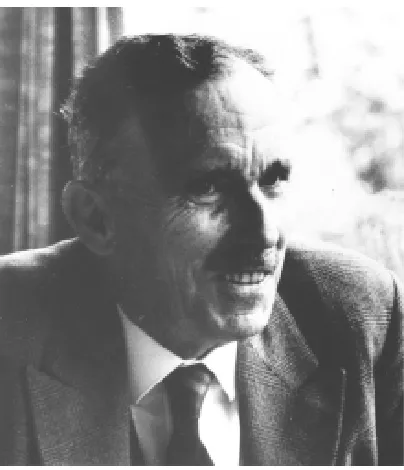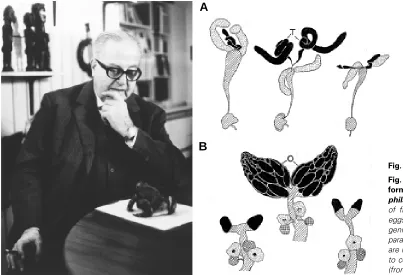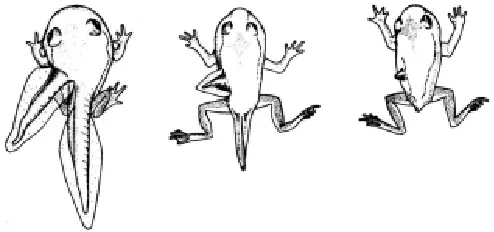The Beginnings of Developmental Biology
in Swiss Universities
0214-6282/2002/$25.00 © UBC Press
Printed in Spain www.ijdb.ehu.es
*Address correspondence to: Dr. Rudolf Weber. Oberwohlenstrasse 43, CH-3033 Wohlen, Switzerland. e-mail: rudolf.weber@datacomm.ch
Introduction
The earliest contribution by a Swiss scientist to “Developmental Biology” can be traced back to the second half of the 19th century, when the young anatomist W. His by his comprehensive investiga-tions on vertebrate embryos laid the foundation of “Descriptive Embryology”. During the first half of the 20th century, interest in animal development was promoted by the arrival of a new genera-tion of academic teachers, who in the wake of the rapidly evolving biological sciences got engaged in the promising field of “Experi-mental Embryology”. It is the aim of this contribution to review the work of the most prominent Swiss pioneers in “Developmental Biology”. In doing so we shall trace their scientific evolution and document their most representative contributions.
Wilhelm His - A Founding Father of “Descriptive
Embry-ology”
His (Fig. 1) was born in 1831 at Basel and grew up in an intellectual environment, because among his family’s friends were leading members of the local university. His began his studies in medicine at the Universities of Basel and Bern and then moved to the University of Berlin, where he got acquainted with the physiolo-gist J. Müller and R. Remak, through whose lectures he became interested in “Developmental Biology”. To complete his studies he went to the University of Würzburg to work with the renowned pathologist R. Virchow. After having passed his M.D. examination at the University of Basel and further stays at the Universities of
Prague, Vienna and Paris, His, at the age of 26, was appointed to a professorship in Anatomy and Physiology at the University of his native town. In 1872 he accepted an invitation by the University of Leipzig to take over the professorship in Anatomy and the direction of the corresponding institute. After a highly successful career as an outstanding scientist and academic teacher His died in 1904 (Fick 1904).
His deserves credit for inaugurating “Descriptive Embryology” as a distinct field of investigation and for providing methodical and conceptual innovations in the study of animal development, as shown below:
The Foundation of “Descriptive Embryology”
Under the impact of Darwin’s theory of evolution (1859) mor-phologists directed their attention to Embryology in order to estab-lish the genetic relationship of organisms, based on the morpho-logical similarities between embryonic stages. In contrast to this approach His considered “Descriptive Embryology” as a field of its own, which should document the stepwise emergence of the embryonic structures from the egg and thus demonstrate that each stage of development appears as the inevitable consequence of the preceding one. Following this conept His conducted detailed studies on the embryonic development of the chick, teleosts, elasmobranchs and man. Taking the chick embryo as example, His (1874) presented his morphological observations and theoretical considerations in a series of original letters to a fellow scientist. As a physiologist he assumed that in the living organism chemical and physical forces are constantly active. Therefore, he concluded that
RUDOLF WEBER*
the folding and stretching events, resulting in the transformation of the flat germ-disk into the cylindrical body in vertrebrate embryos are due to mechanical forces. He even proposed a simple model, made of paper, to visualize the morphogenetic movements in the early chick embryo. In this context, His developed the original hypothesis that each organ, originating from the blastoderm of the chick embryo, has its preformed germ in a definite region of the flat germ-disk (Fig. 2). By this early notion of a fate map, which he called the “principle of organ-forming regions”, His anticipated later theories of “germinal prelocalization” (Wilson 1896).
Reconstruction Procedure for Embryos
To reveal the morphology of embryonic stages, His combined microscopical analysis with image processing. He devised a microtome (His, 1870) for cutting embryos into serial sections. By assembling the microscopical pictures of the sections, it was possible to reconstruct the shape of the embryonic body. It should be noted here that His did this tedious work by himself without any technical assistance and in addition to a heavy load of teaching.
Contributions to Histogenesis
At the beginning of his scientific work, His was mainly concerned with histological problems. Following instigations by his former teacher R. Virchow, he focused his attention on histogenesis, i.e. the appearance of different cell types in the developing embryo. In later studies on the development of the human brain and the nervous system, His (1886) made the important discovery that each nerve fibre actually originates from a single nerve cell, thus laying the foundation for the “Neuron Theory” by the famous Spanish histologist Santiago Ramon y Cajal (1852-1934), according to which the nerve cell or “neuron” constitutes the structural unit of the human nervous system.
Fig. 1. (Left) Wilhelm His (1831-1904).
Fig. 2. (Right) Organ-forming regions in the germ-disk of the chick embryo according to His (1874).
were faked.
Fritz Baltzer - A Promoter of
“Experi-mental Embryology”
Research in “Experimental Embryology” in Swiss universities was inaugurated in 1921 by the appointment of Fritz Baltzer (Fig. 3) as Professor and Head of the De-partment of Zoology at the University of Bern. Baltzer began studies in zoology at the University of Bern, where his father was professor in Geology. He later moved to the University of Würzburg and accomplished his Ph.D. thesis under Th. Boveri – the co-founder of the “chromosomal theory of in-heritance”. After several years as assistant in Boveri’s group, Baltzer joined his former colleague from Würzburg, Hans Spemann, who in the meantime had been appointed to a professorship in Zoology at the University of Freiburg i.Br. In this new environment Baltzer got acquainted with the classical concepts and methods of “Experimen-tal Embryology”. As head of the Zoological Insitute at the University of Bern he developed a very intense and diverse research activity far beyond his retirement in 1954.
The scientific work of Baltzer was stongly influenced by the conceptual heritage of Boveri, for its major goal consisted in elucidating the respective role of nuclear and cytoplasmic factors in the development of sea urchin and amphibian embryos.
Development of Sea Urchin Hybrids
Fig. 3. (Left) Fritz Baltzer (1884-1974).
Fig. 4. (Right) Abnormal distribution of chromo-somes during the first cleavage division of the sea urchin hybrid Paracentrotus lividus (male) x Sphaerechinus granularis (female). The undivided chromosomes in the mitotic spindle are of paternal origin and are eliminated (from Baltzer 1910).
was conducted on diploid and haploid (merogonic) hybrids. De-pending upon the paternal species the development of hybrids was found to vary from highly lethal to fully viable. In hybrid embryos, attaining the pluteus stage, the influence of the paternal genome was usually visible in the skeleton and the body form. On the other hand, the sophisticated analysis of physiological char-acteristics such as respiratory rate, protein and nucleic acid metabolism did not permit the pinpointing of the causative factors of lethality in the hybrid embryos (Chen and Baltzer 1975).
Sex Determination in Bonellia viridis
At the Zoological Station at Naples Baltzer became interested in the worm Bonellia viridis, which exhibits a striking sexual dimorphism. The females are relatively big and consist of a sac-like body and a long contractile proboscis. The males are of minute size and live either attached to the proboscis or within the body cavity of females (Fig. 5). Baltzer (1928) discovered that larvae living free in sea water develop into females, whereas those which are attached to the body of females give rise to dwarf males. Reducing the time of exposure to females resulted in intersexes. Moreover, these studies showed that apparently genetically determined lar-vae exist, which invariably develop into dwarf males. Owing to difficulties in the maintenance of Bonellia under laboratory condi-tions, Baltzer abandoned further work on this peculiar organism, thus leaving open the question of how the sexual differentiation in Bonellia is ultimately controlled.
Development of Hybrid Newt Merogones
In Spemann’s laboratory Baltzer initiated experiments on the role of nuclear and cytoplasmic factors in the development of newt embryos. By ligation of newly inseminated eggs, he obtained fragments with just one sperm nucleus beside fragments, contain-ing the egg nucleus and one or several sperm nuclei, thus produc-ing haploid merogones and diploid individuals, respectively (Fig. 6). To assess the influence of nuclear and cytoplasmic factors, Baltzer focused his attention on the development of haploid merogones. He found that the combination of egg cytoplasm with a sperm nucleus of the same species allowed normal development
into a haploid newt. By contrast, the combination of egg cytoplasm with a sperm nucleus of a foreign species invariably showed reduced developmental potential. These experiments provided for the first time evidence that a haploid set of chromosomes is sufficient to support normal development (Baltzer, 1922), and that the morphogenetic performance of haploid merogones decreases
with increasing taxonomic distance of the nuclear and cytoplasmic components.
Morphogenesis in Newt Chimeras
Baltzer was also interested in evolutionary aspects of develop-ment. Therefore, he initiated with graduate students and research associates extended investigations on the development of newt chimeras, which were obtained by transplantation of organ pri-mordia into embryos of different species or genera of amphibia. The following example refers to the transplantation of the head neural crest from a toad (Bombinator) into the corresponding region of a newt (Triturus) embryo (Fig. 7). The histological analysis of the chimeric embryo revealed that the toad tissue participated in the construction of a visceral skeleton, which, however, was composed of host-specific newt structures and donor-specific toad elements. On the whole the studies on am-phibian chimeras showed that embryonic tissues, depending upon taxonomic relatedness are capable of collaborating to different degrees in morphogenesis. Baltzer (1952) therefore concluded that the extent of morphogenetic cooperation of tissue primordia may reflect the evolutionary relatedness of the species, from which a chimera originated.
The scientific work of Baltzer is impressive not only in terms of its volume, but also of its diversity of topics and methodical originality. He certainly was one of the leading developmental biologists of his generation. His world-wide recognition was also documented by his nomination among the few foreign members of
the Lehmann family, the young zoologist decided to get involved in the upcoming field of “Experimental Embryology”. Thus he worked as research fellow in the laboratory of H. Spemann at the University of Freiburg i.Br. and later in the group of the well-known American representative of “Experimental Embryology” R.G. Harrison at Yale University (New Haven). In 1929 Lehmann got a position as assistant in the group of Baltzer at the Zoological Institute at the University of Bern. Motivated by his interest in the chemical basis of development, Lehmann visited the laboratory of J. Runnström (Stockholm) – an expert on the “Chemical Embryology” of sea urchins – and the Carlsberg Laboratory (Copenhagen) to get acquainted with the sophisticated methods of cytochemistry, de-veloped by K. Linderström-Lang and H. Holter. In 1940 Lehmann was appointed associate professor and head of the Physiology Section at the Bernese Zoological Institute, which by the establish-ment of another group engaged in “Experiestablish-mental Embryology”, became an internationally recognized centre for studies in “Devel-opmental Biology”. In 1954 Lehmann succeeded Baltzer as head of the Zoological Institute, but owing to health problems decided to Fig. 6. Development of newt merogones. (A)The combination of egg
plasm with a sperm nucleus of the same species results in a normally developing haploid andromerogone. (B-D)The combination of egg plasm with a sperm nucleus from a foreign species results in hybrid andromerogones with reduced developmental potential. Egg halves, which in addition to the egg nucleus contain at least one sperm nucleus develop into diploid newts or newt hybrids, depending upon the nuclear cytoplas-mic combination. Abbreviations: alp, Triton alpestris; crist, Triton cristatus; palm, Triton palmatus; taen, Triton taeniatus (from Mangold 1953).
Fig. 7. Development of the visceral skeleton in a chimera of Bombinator and Triton. (A) Scheme of operation. Tr, Triton (newt); Bo, Bombinator (toad). (B) Chimeric visceral skeleton, showing on the left Bombinator elements and on the right structures of Triton (stippled). Dt, dentale; Hy, hyoid; Md, mandibulare; Pq, palatoquadratum; Pr, premaxillare; Sp, spleniale; Tr, trabecula (from Wagner, 1959).
C
D
A
retire prematurely in 1968. As head of the Physiology Section Lehmann, in collaboration with students and research associates, established his own line of research. The main topics were chemi-cal interference with morphogenetic processes and cell division, as well as the relationship between cytoplasmic constituents and the developmental fate of embryonic cells.
Chemically Induced Disturbances in Morphogenesis
Working in Spemann’s laboratory, Lehmann found that the removal of parts from the prospective head mesoderm resulted in specific defects in the development of the brain and the sense organs in newt embryos. In later studies he showed that treatment of neurulae with LiCl produced similar deficiencies, coinciding with a disturbance in the segregation process of the head mesoderm (Fig. 9). These investigations led to the important discovery that the LiCl-induced defects in newt embryos differ depending upon the stage of treatment and the type of organ rudiment (Lehmann 1936). The stage- and regional-specific action of chemicals was further corroborated on the egg of the annelid Tubifex. These results provided an explanation for congenital malformations, such as, for instance phocomelia, induced by the drug thalidomide in human embryos.
Chemical Inhibition of Cell Division and Tissue Growth
Extending the investigation of the chemical inhibition of growth processes, Lehmann and his collaborators used the regenerating tail tip of tadpoles of the South African Toad (Xenopus laevis) as a model. From a large number of compounds, α-aminoketones (supposed inhibitors of protein synthesis) revealed to be effective inhibitors of tail regeneration. These investigations also showed that by treatment with compounds which exert their inhibitory effect
at different stages of regeneration, an enhanced inhibition of tail regeneration may be obtained (Fig. 10). From this result Lehmann suggested that the principle of combined action may provide a guideline for the control of malignant growth.
The Role of Cytoplasmic Constituents in Embryonic Develop-ment
With the advent of the first electron microscope at the University of Bern in the 1950s, Lehmann immediately took advantage of this new tool to investigate the ultrastructural organization of embry-onic cells. In a pioneer study he used stem cells of different developmental fate from Tubifex embryos. Having observed that preparations of distinct stem cells contained submicroscopical particles of different size, Lehmann (1950) expressed the view that distinct populations of cytoplasmic particles may reflect differences in the morphogenetic fate of embryonic cells. However, this rather premature hypothesis was accepted with scepticism by his col-leagues (Kühn 1955).
In contrast to his colleague Baltzer, who was a curious and untiring bench worker, Lehmann was more analytically minded, spending much effort in establishing general concepts on certain aspects of development. In fact, his monumental “Einführung in die physiologische Embryologie” (1945) represents a comprehensive evaluation of the available data on the early development of sea urchins and amphibians. In this review Lehmann made the auda-cious attempt to relate embryonic morphogenesis to ultrastructural and biochemical changes in embryonic cells, thus advocating the close relationship between “Developmental” and “Cell Biology”. Therefore, it is not surprising that Lehmann was actively engaged in the foundation of the “Swiss Society of Cell and Molecular-Biology”.
Fig. 8. (Left) Fritz Erich Lehmann (1901-1970).
Fig. 9. (Right) Lithium-induced disturbance in the segregation of the axial mesoderm in a Triton embryo. Cross-sections through the anterior trunk region, showing the absence of the notochord (B,C) and disturbances in the myotomes and the neural cord (B) in a Li-treated embryo. (A) Normal axial structures in an untreated embryo (from Lehmann 1938).
A
B
Rudolf Geigy - A Pioneer in the Hormonal Control of
Development
Rudolf Geigy (Fig. 11), son of a wealthy industrial family, began his studies in Zoology at the University of Basel. He later moved to the University of Geneva, where the Zoological Institute under the direction of the French scientist Emile Guyénot attracted many young biologists. Geigy accomplished his Ph.D. thesis in “Experi-mental Embryology” as a student of E. Guyénot. After his return to the Zoological Institute at Basel, Geigy initiated investigations on the effects of UV-irradiation on insect development and the mecha-nism of amphibian metamorphosis. He got a lectureship in “Experi-mental Embryology and Genetics” and was appointed to an asso-ciate professorship in 1938. However, Geigy’s promising career in “Experimental Development Biology” took a decisive turn in 1943, when he was asked to set up a Swiss Tropical Institute. Geigy accepted this new task with great enthusiasm, but as he once admitted, he occasionally felt sorry for having given up “Develop-mental Biology”.
UV-Induced Defects in Insect Development
As graduate student, Geigy investigated the effect of UV-irradia-tion on the development of the fruit fly (Drosophila melanogaster). Using an ingenuous device for precise local irradiation of the tiny eggs, he found that application of UV to the posterior pole sup-pressed the formation of pole cells and finally resulted in sterile flies (Fig. 12), indicating the importance of the polar plasm for the development of the germ cells. Later investigations were concerned with UV-induced morphological deficiencies in moths.
The Mechanism of Anuran Metamorphosis
Geigy also inaugurated extensive studies on anuran metamor-phosis, which involves the transformation of the fish-like tadpole into a land-living vertebrate, the frog. To get information on the factors directing the involution of larval structures and the out-growth of organ rudiments into adult organs, he performed trans-plantation experiments. In this way he showed that a tail bud transplanted into the trunk region of a host embryo developed into a normal tail, but regressed simultaneously with the tail of the host
Lehmann and Scholl 1962).
A
B
Fig. 11. (Left) Rudolf Geigy (1902-1995).
at metamorphosis (Fig. 13). Conversely, tissue from the trunk region, transplanted into the tail bud of a host embryo, developed into typical trunk structures, such as skeletal elements, neural tube and intestine, which survived at metamorphosis although the surrounding tail tissues underwent involution. Based on these results, Geigy (1941a) concluded that the morphological changes in anuran metamorphosis are controlled by intrinsic properties of the larval tissues, which are laid down in an organ-specific pattern. In further experiments on the mode of action of thyroid hormone, which induces metamorphosis, Geigy showed that the competence of larval tissues to respond to the hormone becomes established in young tadpoles in an organ-specific sequence and increases during further development (Geigy 1941b).
With this pioneering work on the hormonal control of anuran development, Geigy inaugurated a promising field in “Developmen-tal Biology”, which later on was resumed by the author of this article.
Concluding Remarks
In retrospect, the early contributions of Swiss scientists clearly reflect the evolution of “Developmental Biology” from the purely descriptive to the experimental approach. It is the merit of the pioneer generation to have promoted research in “Experimental Embryology” which attracted an increasing number of students. As a result “Developmental Biology” became the most active field of research in “Animal Biology” in Switzerland between 1940-60. Although the experimental approach provided new information regarding the properties of developing systems, the underlying factors remained largely a matter of speculation. Fortunately, the advent of “Molecular Biology” provided novel and highly efficient tools to unravel at last the heretofore elusive mechanisms that ultimately control developmental processes.
Summary
This contribution describes the pioneer work in Developmental Biology, initiated by Swiss scientists. The anatomist W. His (1831-1904) deserves credit as the founder of “Descriptive Embryology”. Using novel microscopical techniques, he documented the forma-tion of the embryonic body of various vertebrates as an approach to reveal the mechanisms of morphogenesis. Based on studies of the chick embryo, he designed a fate map of the germ-disk, comprising organ-forming regions, from which the corresponding
embryonic structures originate. F. Baltzer (1886-1974) initiated original studies on the role of nuclear and cytoplasmic factors in the development of sea urchin hybrids and newt merogons. Through his experiments on interspecific and intergeneric chimeras of amphibians, he further contributed to the emerging field of “Devel-opmental Genetics”. F.E. Lehmann (1901-70) inaugurated work on “Chemical Embryology” and later moved to “Cell Biology”. His discoveries on stage- and regional-specific inhibition of morpho-genesis by LiCl in newt embryos were important for the under-standing of malformations. Further studies regarding the action of cytostatic substances on tail regeneration in tadpoles were in-tended to yield information on growth control. Original contributions to “Experimental Embryology” were also made by R. Geigy (1902-1995), who devised an ingenuous procedure for obtaining sterile Drosophila flies by UV-irradiation of eggs. In later studies on anuran metamorphosis, he discovered that the morphogenetic effects of the metamorphic hormones are organ-specific and that competence of the larval tissues to respond to thyroid hormone is stage-dependent.
KEY WORDS:
Descriptive embryology, experimental embryology,
developmental genetics, cell biology
References
BALTZER, F. (1910). Über die Beziehung zwischen Chromatin und der Entwicklung und der Vererbungsrichtung bei Echinodermenbastarden. Arch. Zellforsch. 5: 497-621.
BALTZER, F. (1922). Über die Herstellung und Aufzucht eines haploiden Triton taeniatus. Verh. Schweiz. Naturf. Ges. Bern, 248-249.
BALTZER, F. (1928). Über metagene Geschlechtsbestimmung und ihre Beziehung zu einigen Problemen der Entwicklungsmechanik und Vererbung (aufgrund von Versuchen an Bonellia). Verh. Deutsch. Zoolog. Ges. e.V. 32: 273-325.
BALTZER, F: (1952). Experimentelle Beiträge zur Frage der Homologie. Xenoplastische Transplantationen bei Amphibien. Experientia 8: 285-324.
BALTZER, F. (1962). Theodor Boveri. Leben und Werk eines grossen Biologen (1862-1915). In Grosse Naturforscher (Ed. Degen, H.) Bd. 25. Wissenschaftl. Verlagsges. M.b.H., Stuttgart.
CHEN, P.S. and BALTZER, F. (1975). Morphology and biochemistry of diploid and androgenetic haploid (merogonic) hybrids. In The Sea Urchin Embryo (Ed. G. Czihak) pp. 424-472. Springer Verlag, Berlin, Heidelberg, New York.
DARWIN, C. (1859). On the origin of species by means of natural selection or the preservation of favoured races in the struggle for life. Murray, London.
FICK, R. (1904). Wilhelm His. Anat. Anz. 25, No. 7 and 8.
FANTINI, B. (2000). The "Stazione Zoologica Anton Dohrn" and the History of Embryology. Int. J. Dev. Biol. 44: 523-535.
GEIGY, R. (1931). Action de l’ultraviolet sur le pôle germinal dans l’œuf de Drosophila melanogaster (Castration et mutabilité). Rev. suisse Zool. 38: 187-289.
GEIGY, R. (1941a). Die Metamorphose als Folge gewebespezifischer Determination. Rev. suisse Zool. 48: 483-494.
GEIGY, R. (1941b). Thyroxineinwirkung auf verschieden weit entwickelte Froschlarven. Verh. Schweiz. Naturf. Ges. Basel. 161-164.
HAECKEL, E. (1986). Natürliche Schöpfungsgeschichte. Georg Riemer, Berlin.
HIS, W. (1874). Unsere Körperform und das physiologische Problem ihrer Entstehung. Briefe an einen befreundeten Naturforscher. F.C.W. Vogel, Leipzig.
HIS, W. (1870). Beschreibung eines Mikrotoms. M. Schultze’s Arch. Anat. 6: 229.
HIS, W. (1886). Zur Geschichte des menschlichen Rückenmarkes und der Nervenwurzeln. Abh. K.s. Ges. Wissensch., math.-phys. Kl. 13, No. 6.
KÜHN, A. (1955). Vorlesungen über Entwicklungsphysiologie. Springer Verlag, Berlin, Göttingen, Heidelberg.
LEHMANN, F.E. (1936). Selektive Beeinflussbarkeit frühembryonaler Entwicklungsvorgänge. Naturwiss. 24: 401-407.
